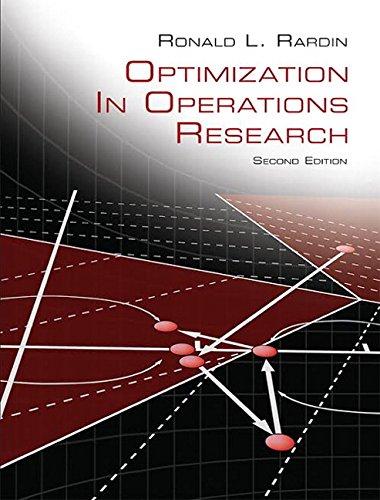The College County Election Board (CCEB) is planning for election machines needed for the coming national election
Question:
The College County Election Board
(CCEB) is planning for election machines needed for the coming national election in the county’s 4 voting precincts. Each machine can be expected to service 100 voters on election day, but the challenge is that the number of voters at each precinct is unpredictable. Precincts 1 an 2 in the more upscale, highly educated part of the county experience fairly consistent voting, but precinct 3, and especially univeristy district precinct 4 are highly volatile. The table below shows the numbers of citizens (in hundreds) whom history suggests would vote in each precinct, depending upon whether the overall election is a Low, Medium, or High turnout one.
Precinct Number Turnout (hundreds)
Low Medium High 1 5 6 7 2 4 7 8 3 2 6 10 4 2 8 15 Prob 0.25 0.35 0.40 The table also shows to probability of the coming election being of each type.
The CCEB must choose how many machines to pre-position at each precinct on election day, and how many more to keep in a warehouse from which they can be distributed to precincts after the shape of the election is revealed in the early hours of voting. Machines cost $5 thousand each to obtain and program plus an additional
$0.5 thousand to relocate any from warehouse to a polling place. The Board wants to stay within its budget of $150 thousand while minimizing the expected total number of voters who have long waits because there are not enough machines at their precinct to meet the demand.
(a) Explain how CCEB’s planning task can be modeled as a Two-Stage Stochastic Program with recourse (definition 4.18 )?
Specifically, what will be decided in Stage 1, what scenarios s need to be treated in Stage 2, and what recourse decisions are available?
(b) Assuming it is satisfactory to treat numbers of voting matching as continuous, formulate a Stochastic Linear Program in Extensive Format (Figure 4.4) to compute a minimum expected-value plan for CCEB. Use Stage 1 decision variables xp ! the number of voting machines
(hundreds) initially positioned at precincts p = 1,c, 4 or at the warehouse p = 5. Combine with Stage 2 decision variables yp 1s2 ! the number of machines
(hundreds) shipped from the warehouse to precinct p under scenario s, and wp 1s2 !
the number (hundreds) of voters at precinct p who will experience long waits due to a shortage of machines under scenario s.
(c) Use class optimization software to solve your model of
(b) and explain what decisions prove optimal.
Step by Step Answer:






